#Infanta Maria Luisa
Photo



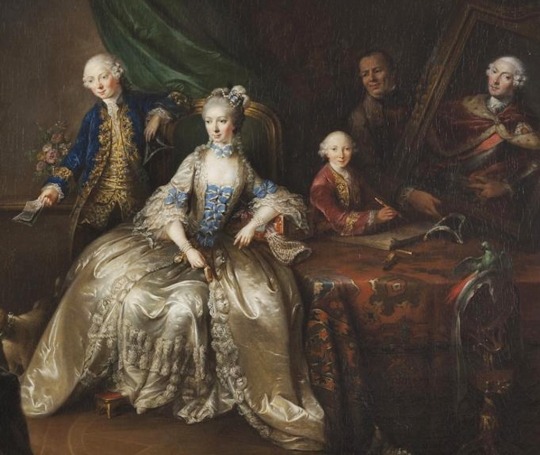


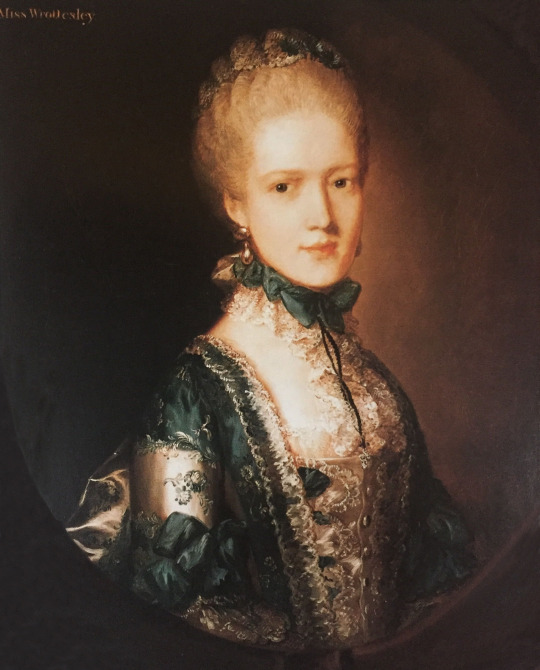
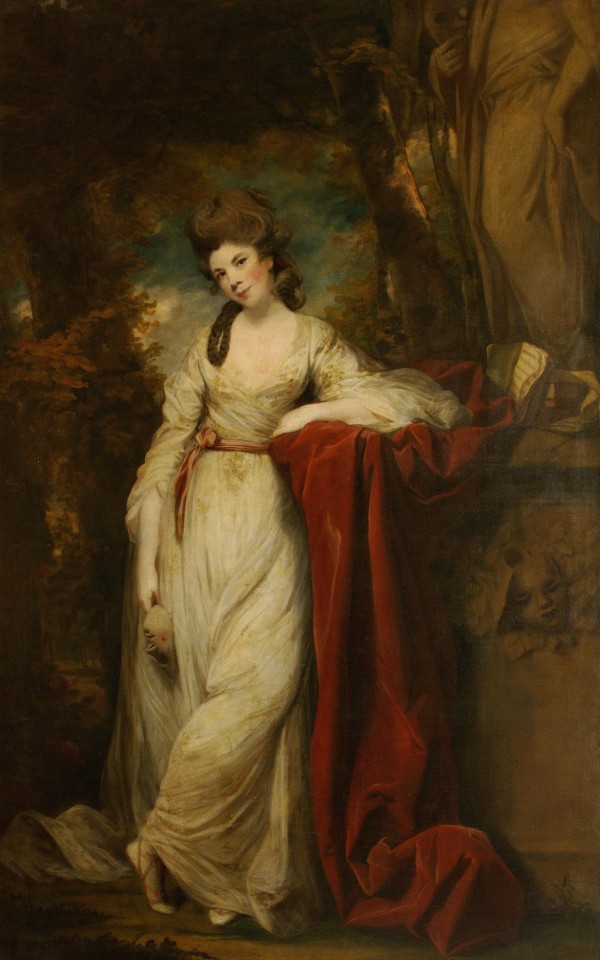
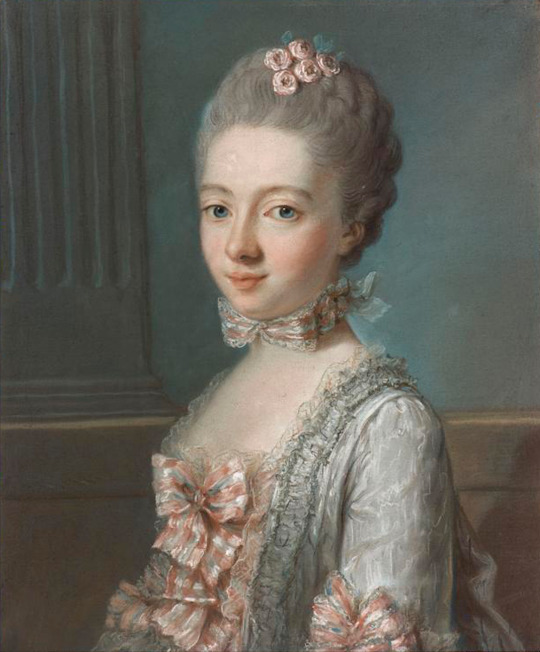
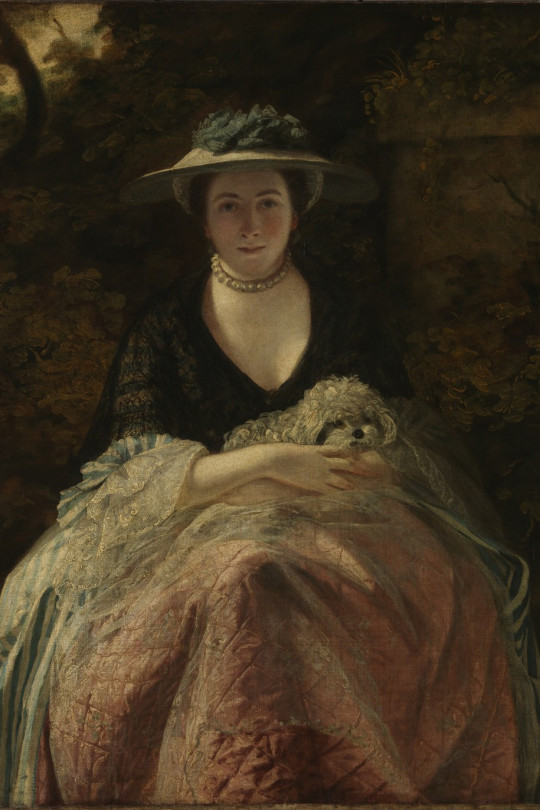
1764 Fashion -
Top: 1764 Infanta Maria Luisa by Anton Rafael Mengs (Kunsthistorisches Museum - Wien, Austria). From Animus Mirabilis' photostream on flickr; erased spots w Pshop 1146X1474 @72 585kj.
Second row left: 1764 Mary Anne Colmore by Francis Cotes (Worthing Museum and Art Gallery - Worthing, West Sussex. UK). From artuk.org 1496X1898 @72 4.1Mp.
Second row right: 1764 Lady Amelia Darcy, 9th Baroness Conyers by François Hubert Drouais (Bowes Museum - Durham, North East England, UK). From Wikimedia 1579X1899 @72 893kj.
Third row: 1764 Marianne Camasse, Countess of Forbach, morganatic wife of Christian IV by Johann Christian Mannlich (private collection). From Wikimedia; enlarged by half 1022X861 @96 235kj.
Fourth row: 1764 Mary, Countess of Howe by Thomas Gainsborough (Kenwood House - Hampstead, London, UK). From mfah.org/blogs/inside-mfah/characters-kenwood-mary-countess-howe 951X1350 @96 262kj
Fifth row left: 1764-1765 Elizabeth Wrottesley, later Duchess of Grafton by Thomas Gainsborough (National Gallery of Victoria - Melbourne, Victoria, Australia) Google Art Project via Wikimedia; blurred bacgrounf to erase cracks 3930X5152 @38 6.8Mj.
Fifth row right: 1764 Mary Wrottesley by Thomas Gainsborough (location ?). From pinterest.at/heritagerose/painting/; fixed lower left corner area and halfway up left side with Photoshop to remove a veiling reflection 2151X2669 @72 1.3Mj.
Sixth row: 1764 Mrs Abington as The Comic Muse, by Sir Joshua Reynolds (Waddesdon Manor - Waddesdon, Buckinghamshire, UK). From Wikimedia 2217X3537 @300 1.3Mj.
Seventh row left: 1764 Madame Lalive de Jully by Joseph Ducreux (Musée Antoine Lécuyer - Saint-Quentin, Aisne, Hauts-de-France, France) photo - Mathieu Rabeau. From Réunion des Musées nationaux Web site; enlarged to fit screen 2380X2872 @144 7.1Mp.
Seventh row right: 1762-1764 (between) Miss Nelly O'Brien by Sir Joshua Reynolds (Wallace Collection - London, UK). From wsimag.com/wallace-collection/artworks/58035 915X1173 @300 427kj.
#1764 fashion#Rococo fashion#Louis XV fashion#Georgian fashion#Infanta Maria Luisa#Anton Rafael Mengs#Mary Anne Colmore#Francis Cotes#Amelia Darcy#François-Hubert Drouais#Marianne Camasse#Johann Christian Mannlich#Mary - Countess of Howe#Thomas Gainsborough#Elizabeth Wrottesley#Mary Wrottesley#Mrs Abington#Joshua Reynolds#Madame Lalive de Jully#Joseph Ducreux#nelly o'brien
21 notes
·
View notes
Text
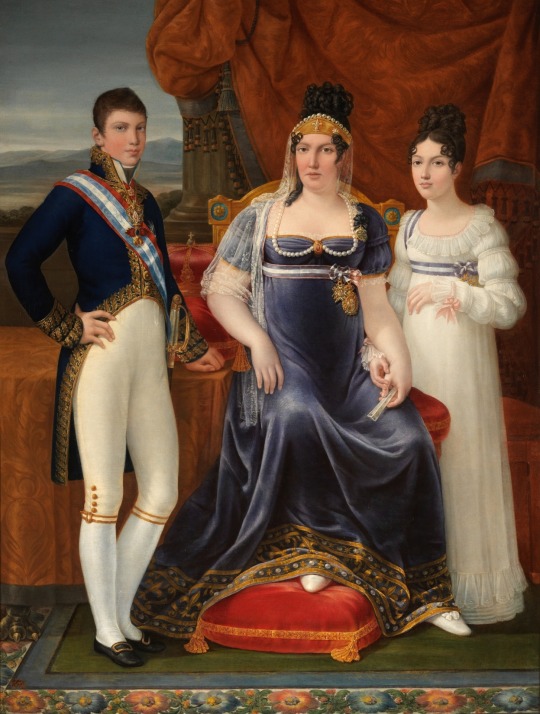
The Queen of Etruria and her children. By José Aparicio e Inglada.
#maria luisa di spagna#duchessa di lucca#borbone di parma#ducato di parma e piacenza#carlo ludovico di borbone#duca di parma#casa di borbone#parma#museo del prado#infantes de españa#casa de borbón#maria luisa de borbón#infanta de españa#josé aparicio#josé sparecio e inglada
7 notes
·
View notes
Photo
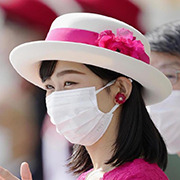






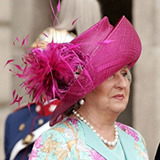

Royal Hat Appreciation (328/∞)
#queen maxima#princess diana#queen Silvia#princess claire of luxembourg#princess luisa maria#princess louise of belgium#princess kako#lady frederick windsor#infanta pilar#royaltyedit#royal fashion#hat spam#mine
37 notes
·
View notes
Photo
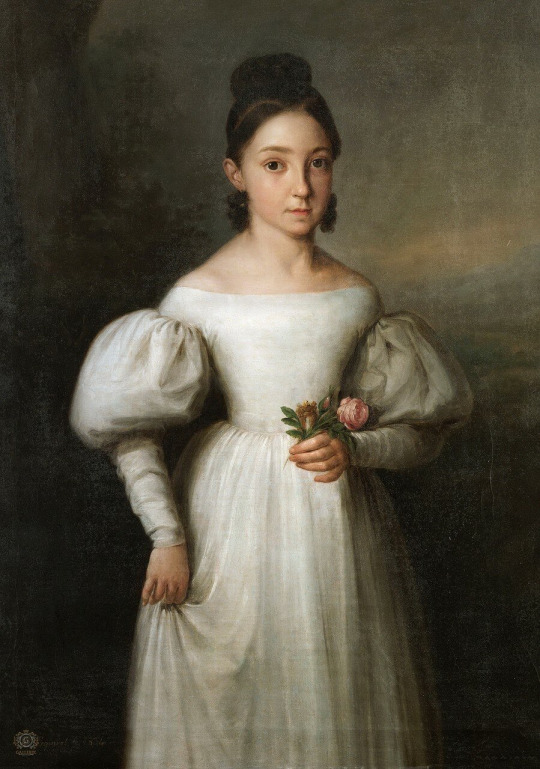
Antonio María Esquivel y Suárez de Urbina (Spanish, 1806-1857)
Portrait of Infanta Maria Luisa Teresa de Bourbon, Duchess of Sessa, Infanta of Spain, 1834
Museo Del Prado
#Antonio María Esquivel#Antonio María Esquivel y Suárez de Urbina#spanish art#european art#world history#classical art#western civilization#fine art#fine arts#oil painting#portrait of a young girl#infanta of spain#spanish princess#duchess#art#history#europe#european#europa
53 notes
·
View notes
Text
So I was looking for pictures of archduchess Sophie in Wikimedia, as one does, and I stumbled with the portrait in the left. This portrait immediately seemed VERY familiar to me - and it didn't took me long to realize why: it's a different version of a portrait of Ludovika of Bavaria, Empress Elisabeth's mother.
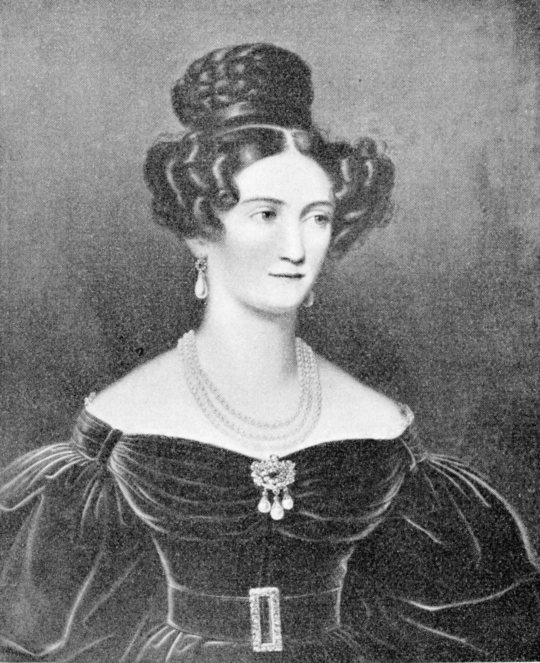

Although it's in Sophie's Wikimedia page, this portrait was first posted in weber-gesamtausgabe.de, a website about composer Carl Maria von Weber, as a portrait Princess Maria Luisa Carlota of Bourbon-Parma, daughter of King Luis I of Etruria and Infanta Maria Luisa of Spain, who later married Prince Maximilian of Saxony.
The first thing that I thought is that the Weber website simply misidentified the sitter, but I decided to keep looking further. The website sourced the image as coming from Fürsten-Bildnisse aus dem Hause Wettin, by Jean Louis Sponsel, published in Dresden in 1906. I crossed my fingers, googled it and guess what: the whole book is available for free in the Saxon State and University Library.
It didn't took me long to find the picture in question:
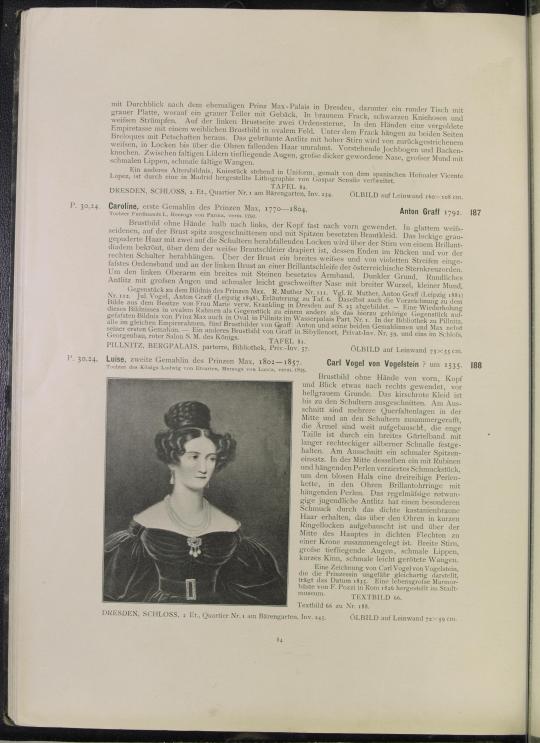
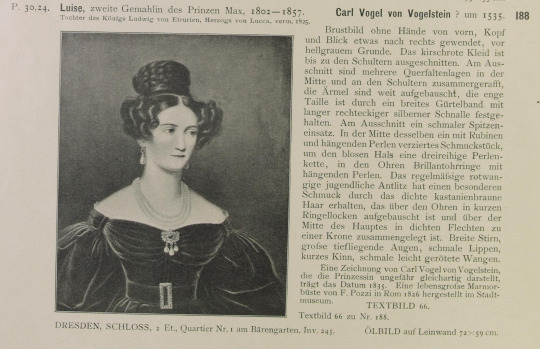
The text reads as it follows:
Luise, second wife of Prince Max, 1802-1857. daughter of King Louis of Etruria, Duke of Lucca, married, 1825.
Carl Vogel von Vogelstein? c. 1535 [a typo, the author likely meant 1835]
Half-length portrait without hands from the front, head and gaze turned a little to the right, in front of a light grey background. The cherry-red dress is cut to the shoulders. The neckline is gathered in several cross folds in the middle and at the shoulders, the sleeves are widely puffed out, the narrow waist is held in place by a wide belt band with a long rectangular silver buckle. A narrow lace insert at the neckline. In the centre a jewel decorated with rubies and hanging pearls, around the bare neck a three-row pearl necklace, in the ears diamond earrings with hanging pearls. The regular, red-cheeked, youthful face has been given a special adornment by the thick chestnut-brown hair, which is puffed up above the ears in short ringlets and over the middle of the head is laid together in dense braids to form a crown. Broad forehead, large deep-set eyes, narrow lips, short chin, narrow slightly flushed cheeks.
A drawing by Carl Vogel von Vogelstein depicting the princess in approximately the same manner bears the date 1835. A life-size marble bust by F. Pozzi made in Rome in 1826 in the City Museum.
The colors described match with the Ludovika portrait, so to me at least there is almost no doubt of it being the same. But that left with a bigger question: who is the sitter then?
Short answer, I have no idea. I'm no art historian, and I can't go to the Schloss Dresden to check if they still have this portrait somewhere in their collection. What I can do is speculate with the little information that I have, so I decided to do just that.
Here we have a close up of an engraving of Luisa Carlota with no date (left), the Dresden portrait with the mysterious sitter (middle), and a close up of a painting of Luisa Carlota by Vogel - likely the one referenced in Sponsel's book, I couldn't find any other -, dated 1834 (right):

And here we have a close up of a miniature of Ludovika (left), the Dresden portrait (middle), and a close up of Ludovika's engagement portrait by Stieler (right):
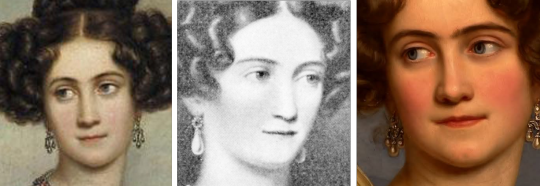
Perhaps I'm being biased, but I can see a strong resemblance between the Dresden portrait and the two portraits of Ludovika. I can't really see much similarities with the two images of Luisa (though to be fair, the engraving and the Vogel portrait don't look super similar either, and both are confirmed pictures of her). To me, the detail that makes me think that the Dresden portrait is indeed Ludovika is the eye color. Luisa seems to have brown eyes in the Vogel portrait. Ludovika has blue eyes in both of her portraits. The same eye color that the woman in the red dress identified as Ludovika has - which is likely also the eye color of the Dresden portrait's sitter.
Lastly, here is a picture of the portrait with the frame, in which the inscription identifying Ludovika can be seen:
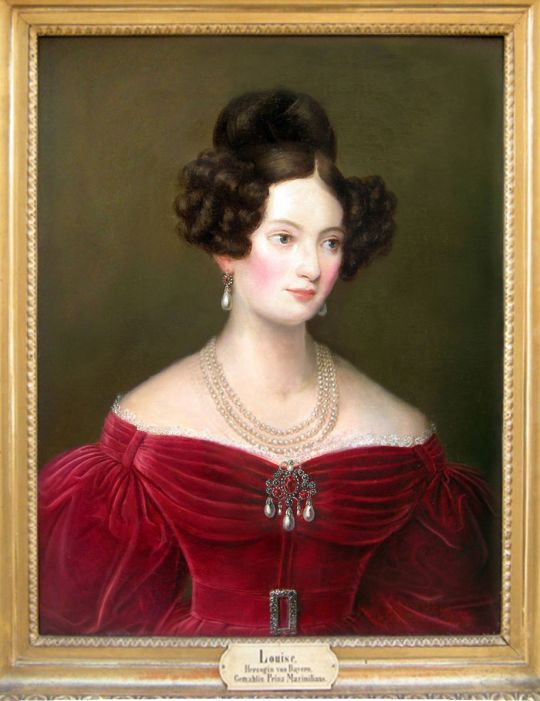
This is all I could find on the subject. If I learn anything more I'll tell you!
#i am once again trying to identify a portrait#ludovika of bavaria duchess in bavaria#luisa carlota of bourbon-parma princess of saxony#art
19 notes
·
View notes
Text
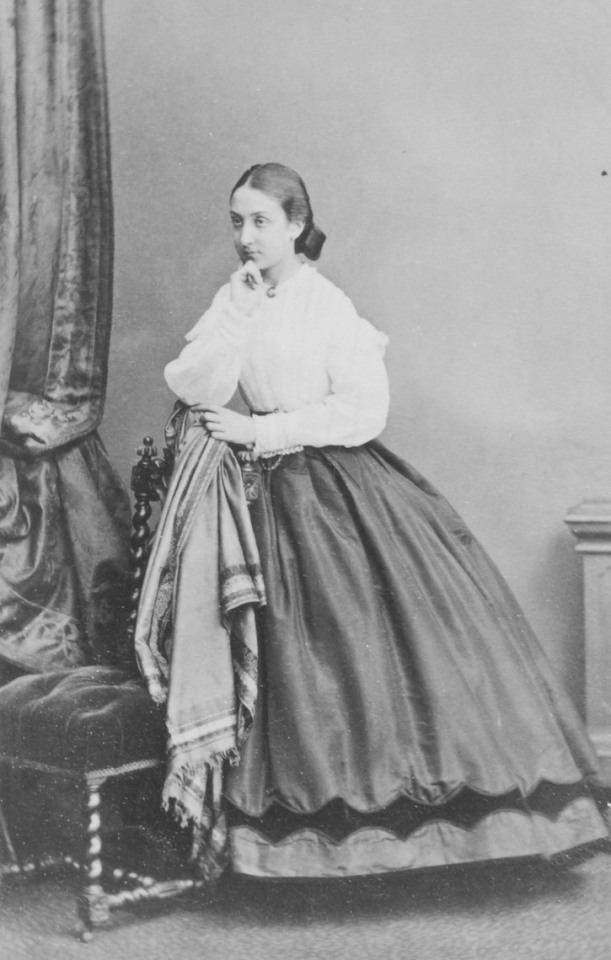
Princess Maria Amelia of Orléans, Infanta of Spain (28 August 1851 – 9 November 1870) was a Princess of Orléans and Infanta of Spain who was the second child of Antoine, Duke of Montpensier and Infanta Luisa Fernanda, Duchess of Montpensier. She was a paternal granddaughter of Louis Philippe I and maternal granddaughter of Ferdinand VII of Spain.
#Maria Amalia of Orléans#xix century#people#House Orléans#portrait#photo#photography#black and white
2 notes
·
View notes
Text
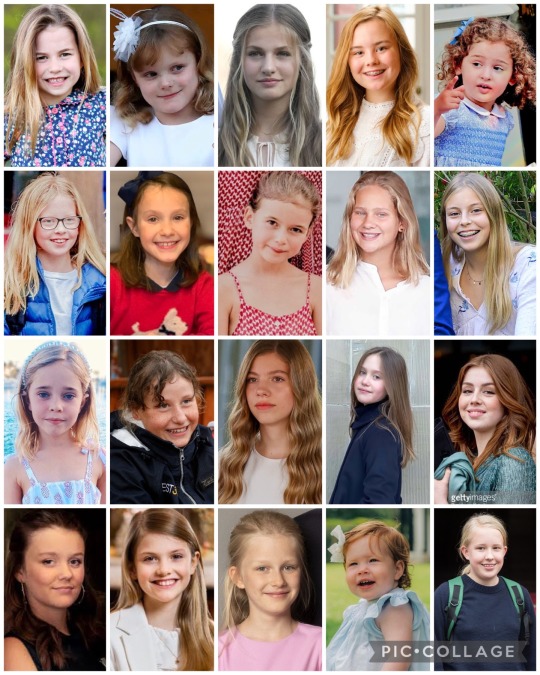


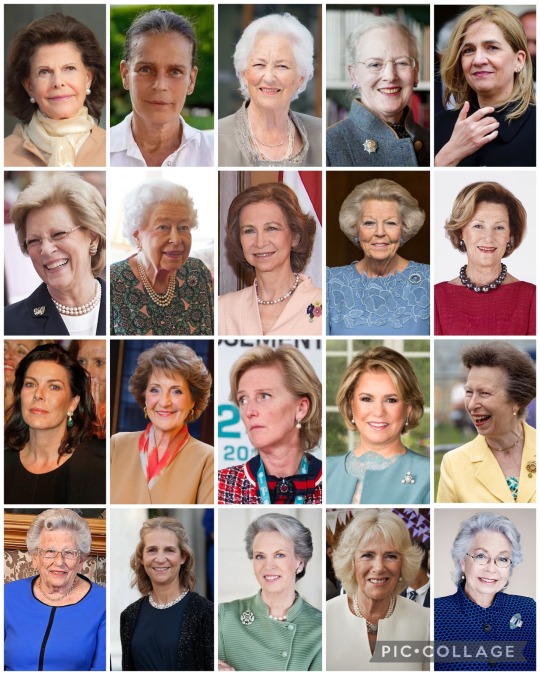
Royal women
1. Princess Charlotte of Cambridge
2. Princess Gabriella of Monaco
3. The Princess of Asturias
4. Princess Ariane of The Netherlands
5. Princess Adrienne of Sweden
6. Countess Zaria of Orange Nassau
7. Princess Athena of Denmark
8. Princess Amalia of Nassau
9. Irene Urdangarin
10. Countess Leonore of Orange Nassau
11. Princess Leonor of Sweden
12. Emma Behn
13. Infanta Sofia of Spain
14. Princess Josephine of Denmark
15. Princess Alexia of The Netherlands
16. Princess Isabella of Denmark
17. Princess Estelle of Sweden
18. Princess Elèonore of Belgium
19. Lilibet Mountbatten-Windsor
20. Countess Luana of Orange Nassau
21. Princess Louise of Belgium
22. The Duchess of Brabant
23. Princess Eugenie of York
24. Leah Behn
25. Countess Eloise of Orange Nassau
26. Maud Behn
27. Princess Laetita of Belgium (also archduchess of Austria Este)
27. Princess Ingrid Alexandra of Norway
29. Camille Gottlieb
30. Victoria Federica Marichalar
31. Princess Alexandra of Luxembourg
32. The Princess of Orange
33. Princess Alexandra of Hannover
34. Princess Elisabetta of Belgium (also archduchess of Austria Este)
35. Princess Maria Laura of Belgium (also archduchess of Austria Este)
36. Charlotte Casiraghi
37. Princess Beatrice of York
38. Princess Maria Luisa of Belgium (also archduchess of Austria Este)
39. Pauline Ducruet
40. Lady Louise Mountbatten-Windsor
41. The Countess of Wessex
42. Crown Princess Mary of Denmark
43. Queen Mathilde of the belgians
44. Princess Sofia of Sweden
45. Princess Martha Louise of Norway
46. Crown Princess Victoria of Sweden
47. Crown Princess Mette-Marit of Norway
48. Queen Maxima of the Netherlands
49. Princess Stèphanie of Luxembourg
50. Princess Marie of Denmark
51. Queen Letizia of Spain
52. Princess Mabel of Orange Nassau
53. Princess Madeleine of Sweden
54. The Duchess of Cambridge
55. Princess Claire of Luxembourg
56. Princess Claire of Belgium
57. The Duchess of Sussex
58. Princess Charlène of Monaco
59. Zara Tindall (neé Phillips)
60. Princess Laurentien of The Netherlands
61. Queen Silvia of Sweden
62. Princess Stèphanie of Monaco
63. Queen Paola of Belgium
64. Queen Margrethe II of Denmark
65. Infanta Cristina of Spain
66. Queen Anne Marie of Greece (née princess of Greece)
67. Queen Elizabeth II
68. Queen Sofia of Spain
69. Princess Beatrix of The Netherlands
70. Queen Sonja of Norway
71. Princess Caroline of Monaco (also princess of Hannover)
72. Princess Margriet of The Netherlands
73. Princess Astrid of Belgium (also archduchess of Austria Este)
74. Grand Duchesse Maria Teresa of Luxembourg
75. The Royal Princess
76. Princess Astrid of Norway
77. Infanta Elena of Spain
78. Princess Benedikte of Denmark (also princess of Sayn Wittgenstein)
79. The Duchess of Cornwall
80. Princess Christina or Sweden
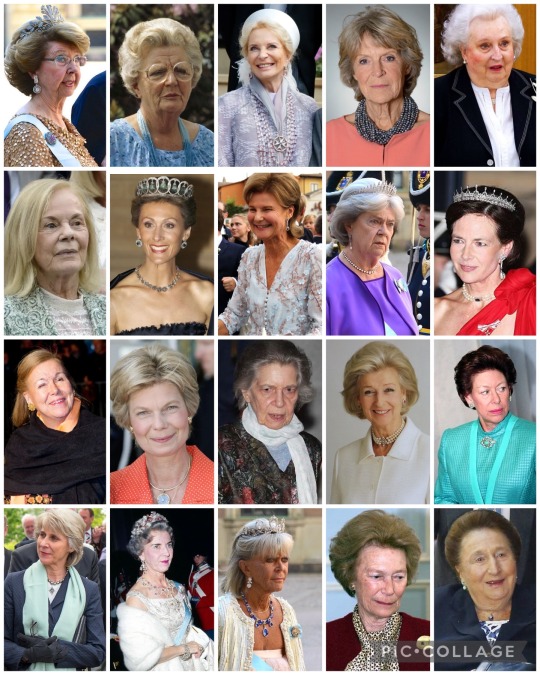
Plus other royal women that support or had supported the Crown
1. Princess Desiree of Sweden
2. Queen Juliana of The Netherlands
3. Princess Michael of Kent
4. Princess Irene of The Netherlands
5. Infanta Pilar of Spain
6. The Duchess of Kent
7. Princess Sibilla of Luxembourg
8. Princess Margaretha of Luxembourg (also princess of Liechtenstein)
9. Princess Margaretha of Sweden
10. Countess Diane of Nassau
11. Princess Christina of The Netherlands
12. Princess Marie-Astrid of Luxembourg (also archduchess of Austria Este)
13. Princess Irene of Greece
14. Princess Alexandra of Kent
15. Princess Margaret, countess of Snowdon
16. The Duchess of Gloucester
17. Queen Ingrid of Denmark (née princess of Sweden)
18. Princess Birgitta of Sweden
19. Grand Duchesse Josephine Charlotte of Luxembourg (née princess of Belgium)
20. Infanta Margarita of Spain
#princess charlene#princess charlotte#princess estelle#princess leonore#princess madeleine#princess josephine#princess alexia#princess mary of denmark#princess elisabeth#princess eugenie#princess beatrice#princess beatrix#princess gabriella#princess amalia#princess ariane#princess adrienne#princess leonor#infanta sofia#infanta cristina#infanta elena#princess athena#princess isabella#irene urdangarin#princess eleonore#lilibet#meghan markle#kate middleton#queen maxima#queen mathilde#queenletizia
11 notes
·
View notes
Text
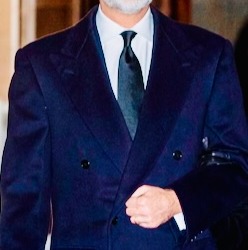
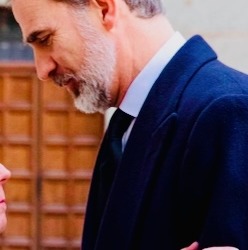


Through the Years → Felipe VI of Spain (2,466/∞)
29 January 2020 | Spain's King Felipe VI and Queen Letizia arrive to attend the funeral for Infanta Pilar of Spain, Duchess of Badajoz and Viscountess of La Torre, commonly known as Pilar de Borbon, at the basilica of the Royal Site of San Lorenzo of El Escorial in San Lorenzo del Escorial . The elder sister of King Emeritus of Spain, Juan Carlos I, Maria del Pilar Alfonsa Juana Victoria Luisa Ignacia y Todos los Santos de Borbon y Borbon, or simply known as Pilar de Borbon, passed away on January 8, 2020 at the age of 83 in a hospital in Madrid. (Photo by Emiilio Naranjo/Pool/AFP via Getty Images)
1 note
·
View note
Text
It is one of the largest and most well-known green spaces in the city. The park is located next to the Plaza de España and was donated to the city by Infanta María Luisa Fernanda de Borbón in 1893. The park’s design combines elements of formal gardens and more informal areas, featuring fountains, statues, gazebos, and tree-lined avenues.
Within the Maria Luisa Park, you will also find the Plaza de América, which houses several Mudéjar-style buildings that are part of the Ibero-American Exposition of 1929.
0 notes
Photo
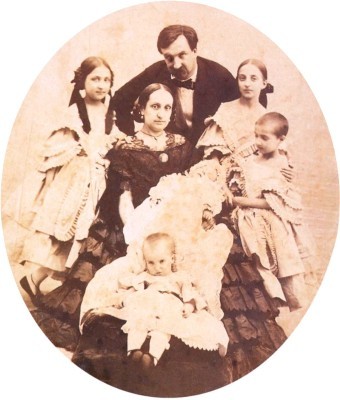
Infanta Luisa Fernanda of Spain, Duchess of Montpensier, with her husband, Antoine, and their children.
#Infanta Luisa Fernanda of Spain#Duchess of Montpensier#Orleans#Infanta of Spain#Princess of Orleans#Prince Antoine of Orleans#Duke of Montpensier#Infanta Maria Isabella of Spain#Countess of Spain#Princess Marie Isabelle of Orleans#History#Royalty#Princess
16 notes
·
View notes
Text
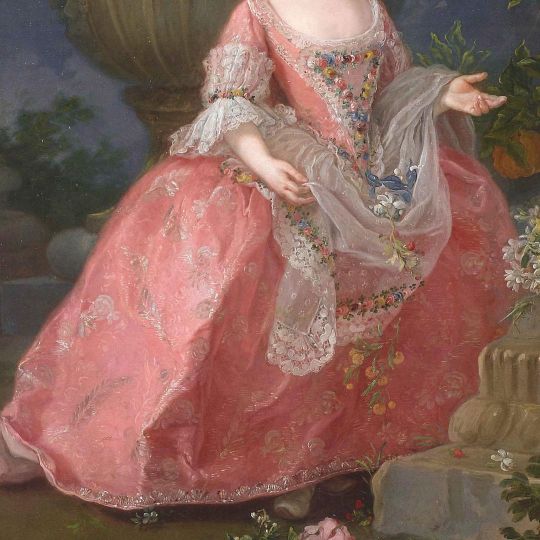
Portait of Infanta Maria Luisa of Spain, Guiseppe Bonito.
#mypost#art#aesthetic#art history#history of art#artist#art details#art detail#art lover#museum#museums#woman in art#women in art#fashion#rococo#baroque#renaissance art#renaissance#painting#oil painting#modern art#art museum#history#exhibition#museumlover#art museums#baroque art#art curator#curator#details
115 notes
·
View notes
Photo

Infanta Maria Luisa of Spain by Italian school (auctioned by Revere Auctions). 3Nov21 auction Lot 11; removed spots and flaws with Photoshop 1000X1326 @72 404kj. The area above the dog's tail and behing her chair have been extensively redone.
#Infanta Maria Luisa#straight hair#high coiffure#flowered hat#fichu#V neckline#full sleeves#lace engageantes#bow#fan
8 notes
·
View notes
Photo
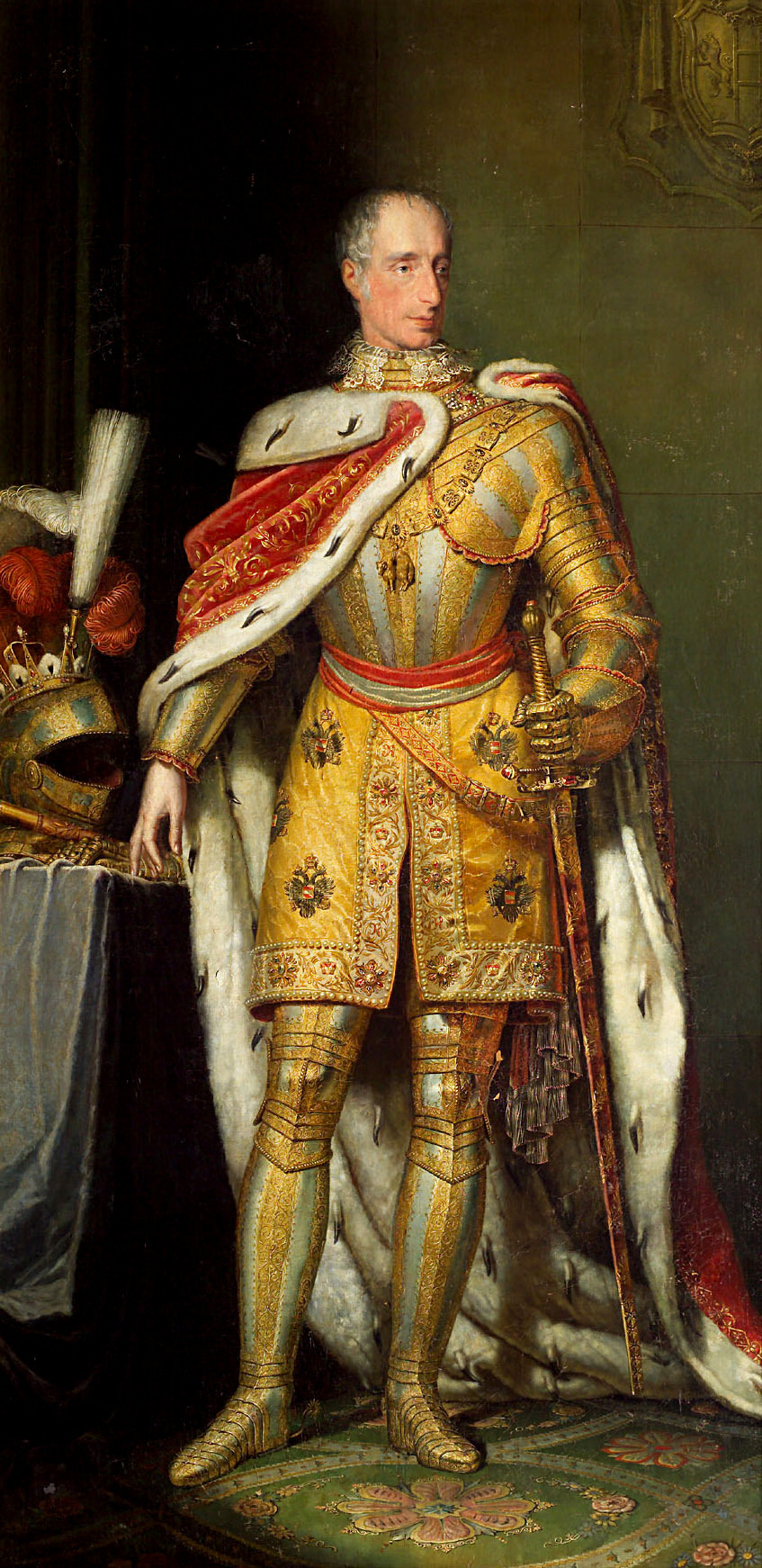
Archduke Rainer (1783-1853), Vice chancellor of Veneto and Lombardy; son of Leopold II. By Carl von Sales.
He was the son of Emperor Leopold II and Infanta Maria Luisa of Bourbon.
Raniero served as Viceroy of the Kingdom of Lombardy-Venice from 1818 to 1848. The position he held had few administrative responsibilities, but it made Raniero and his wife the head of the Austrian court in Milan.
#carl von sales#erzherzogtum österreich#erzherzog#erzherzog rainer#in armour#full length portrait#haus habsburg lothringen#full-length portrait#house of habsburg lorraine#Vizekönig von Lombardo Venetien#Kunsthistorisches Museum
23 notes
·
View notes
Text



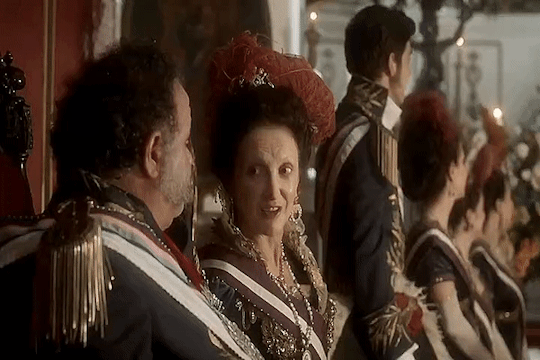

Carlota Joaquina de Borbón (1775 – 1830)
She was the second child of King Carlos IV of Spain and Maria Luisa of Parma. Despite the rigidity of her education and court etiquette, the Infanta was described as mischievous and playful. Maria Luisa would go down in history as one of the most unpopular queens in Spain and her bad reputation deeply affected her children, especially Carlota, the firstborn daughter.
Carlota Joaquina married King João VI of Portugal in 1785. Detested by the Portuguese court — where she was called "the Shrew of Queluz"— Carlota Joaquina gradually won the antipathy of the people, who accused her of promiscuity and influencing her husband in favor of the interests of the Spanish crown.
Carlota Joaquina's husband was good-natured, indolent, corpulent and almost as ugly as she was. His religious observances bored her, and they were quite incompatible. Nevertheless, she gave birth to nine children during their marriage and, because they were all handsome, it was rumoured that especially the younger ones had a different father.

Carlota Joaquina organized a plot with the intention to take the reins of power from her husband, arresting him and declaring that he was incapable of rule like his mother. However in 1805 this plot was discovered, but Carlota Joaquina was saved because her husband, wishing to avoid a public scandal, opposed to her arrest, preferring to confine his wife to Queluz Palace and Ramalhão Palace, while he himself moved to Mafra Palace, effectively separating from her. At that time Carlota Joaquina's enemies claimed that she had bought a retreat where she indulged in sexual orgies.
In 1807, the Portuguese royal family left Portugal for Brazil because of the Napoleonic invasion. Carlota Joaquina also planned to usurp the Spanish crown that was in the hands of Napoleon's brother Joseph Bonaparte. After the marriage in 1817 of her son Pedro with the Archduchess Leopoldina of Austria and the later return of the royal family to Portugal in 1821, Carlota Joaquina was confined in the Royal Palace of Queluz. Her husband died in March 1826. Claiming ill-health, Carlota Joaquina refused to visit his deathbed and started the rumour that her husband had been poisoned by the Freemasons. Carlota Joaquina died in Queluz four years after, alone and abandoned by her children. It is speculated whether she died because of natural causes or whether she, in fact, killed herself.
Débora Olivieri portrays Queen Carlota Joaquina in "Novo Mundo 2017"
#Carlota Joaquina de Borbón#Women in history#Portuguese history#Brazillian history#João VI of Portugal
14 notes
·
View notes
Photo






Mejores destinos para los Hijos de los Reyes Católicos- María de Aragón
María fue la hija mas desconocida de los Reyes Católicos siendo considerada bonita, pero no tanto como sus hermanas. La infanta era piadosa, caritativa y prudente ante todos los conflictos que estuvieron ocurriendo en la familia Trastamara.
En un principió se pensó en comprometerla con el rey James IV de Escocia, pero las negociaciones matrimoniales no llegaron a mucho y el rey se acabaría casando con la princesa Margarita Tudor.
Tras su compromiso fallido, su hermana mayor la reina de Portugal Isabella de Aragón negocio un matrimonio para María con el duque de Viseu y Beja, Manuel de Avís que era hermano de la reina viuda Leonor de Viseu.
Manuel de Viseu no estaba muy convencido por aquella unión debido a que el tenia sentimientos escondidos por la reina Isabella, pero accedió a casarse con la infanta para asegurar la sucesión de sus ducados.
Las negociaciones matrimoniales apenas duraron un año al ser Isabella de Aragon la mediadora de aquel compromiso y María partió hacia Portugal en 1500 llegando hasta la ciudad de Alcácer do Sal donde se celebro la boda.
Manuel y María se enamoraron a primera vista durante la ceremonia. Manuel llego a considerar a su esposa como “una flor hermosa, delicada y pequeña” e incluso llego a agradecer por carta a la reina Isabella de Aragón por haber formado aquella alianza ya que de esa forma conoció a su gran amor.
María fue nombrada Duquesa consorte de Viseu y Beja tras casarse con Manuel. La pareja viajo al ducado de Viseu donde fueron bien recibidos nada mas entrar y María fue aclamada por todo el mundo.
Los reyes de Portugal les otorgaron como regalo de bodas los títulos de duques de Trancoso, Guimarães y una parte del ducado de Guarda, siendo los primeros Duques del ducado Guarda-Viseu.
En el ducado se celebraron sencillos, pero bellos bailes en honor a la nueva duquesa y también se llevo a cabo un torneo de justas donde participo Manuel. Se dice que el duque paro su montura ante su esposa y le dio una rosa roja como símbolo de su gran amor y pasión, lo que provoco que María fuera llamada por los nobles y el pueblo como “La rosa de Viseu”.
María se quedo embarazada casi dos años después de casarse con su marido y alumbro en 1502 a su primer hijo, Juan que sería Duque de Viseu.
Pese a que al principio se creía que la duquesa tenia problemas de fertilidad, ella acabaría dándole a su marido 10 hijos seguidos:
Juan de Viseu (1502-1554) Fue duque de Viseu y miembro del consejo del rey Juan III de Portugal. El duque se caso con su prima, Catalina de Austria y tuvieron 4 hijos: Manuel, Felipe, María Manuela y Juan Manuel.
Isabella de Portugal (1503-1547) Fue Emperatriz consorte del Sacro Imperio Romano Germánico al casarse con su primo, Charles V y al sirvió como su regente al lado de su tía-suegra, Joanna. Isabella y Charles tuvieron 5 hijos: Philip I, Maria, Ferdinand, Joanna y John.
Beatriz de Portugal (1504-1538) Fue Duquesa consorte de Saboya al casarse con Carlos III de Saboya y tuvieron 3 hijos vivos: Manuel Filiberto I, Catalina y Isabella. Beatriz fue el tercer vástago en morir antes que su madre.
Luis de Beja (1506-1555) Fue Duque de Beja como herencia paternal. Luis tuvo distintos enfrentamientos con su hermano mayor debido a su supuesto casamiento morganático con una judía. Pese a esto Luis se casaría con su prima, Dulce de Portugal y esta le daría 5 hijos: Luisa, Ana, Luis, Alonzo y Dulce.
Fernando de Guarda (1507-1545) Fue Duque de Guarda-Viseu al dividirse una parte de estos territorios. Se caso con Guiomar Coutinho y tuvieron dos hijos: Luisa y Fernando de Guarda.
Alfonso de Portugal (1509-1548) Fue sucesivamente obispo de Guarda, cardenal, obispo de Viseu, obispo de Évora y finalmente arzobispo de Lisboa. Al morir inesperadamente en 1548 sus títulos fueron heredados a su sobrino, Don Teobaldo de Portugal que fue su estudiante.
María de Portugal (1511-1513) Falleció a los casi 2 años de edad, siendo su muerte una gran tristeza para su madre.
Enrique de Trancoso (1512-1580) Fue duque de Trancoso y miembro importante del consejo del rey Juan III. Enrique no se caso hasta el 1554 con la noble sueca, Catalina Stenbock con la cual tuvo 3 hijos: Enrique, Birgitta y Gustavo.
Eduardo de Guimarães (1515-1549) Fue duque de Guimarães. Se caso con Isabella de Braganza y tuvieron 3 hijos: María, Catalina y Eduardo de Guimarães.
Antonio (1516) Falleció poco después de nacer.
Tras el nacimiento de su hijo Antonio y el fallecimiento de este, María se negó a traer mas hijos al mundo y verlos morir antes que ella. Esto fue aceptado por Manuel que se mantuvo fiel a su esposa pese a no volver a compartir el lecho.
María fue una madre dedicada y amorosa dejando una gran huella en sus hijos que siempre guardaron buenos recuerdos de su progenitora.
La duquesa no se entrometió en la política portuguesa, aun que llego a recibir a los distintos embajadores extranjeros que visitaban el ducado y se dice que María dejaba una buena impresión, además de tener un perfecto portugués a la hora de entablar conversaciones con los visitantes.
También fue una mujer muy piadosa y ayudo a diferentes conventos, organizaciones religiosas y monasterios a fundar sus propias escuelas o edificios santos.
María sufrió mucho con las muertes de algunos de sus hijos que fallecieron antes que ella y su marido. Su hija Beatriz falleció debido a la tuberculosis en 1538 y María guardo luto por su hija por año, además de permanecer unos meses en la corte saboyana junto a sus nietos, hijos de Beatriz.
Otro de sus hijos fue Fernando que falleció tras varios días de padecer viruela en 1545.
María llevo estas muertes como pudo, pero en el año 1547 falleció su hija mayor, Isabella tras un cáncer de mama y dos meses después su marido murió debido a una arritmia cardiaca. Estas muertes fueron un gran dolor para María que se refugió en la religión al igual que sus hermanos.
También solía visitar el Sacro Imperio para ver a sus nietos los archiduques y visito a su hermana mayor, Juana en su residencia de Tordesillas y ambas se consolaban ante las perdidas que iban pasando cada una.
Su hijo Alfonso fallecería inesperadamente en 1548 y María se mantuvo al lado de su hijo que falleció en sus brazos. La muerte de su hijo la marco de por vida y se resguardo aun mas en la religión, llegando a usar prendas mas aptas de una monja en vez de una duquesa o viuda.
María empezó a sufrir graves problemas de corazón a inicios del 1549 y permaneció en cama por varios meses hasta que falleció unos días antes de cumplir los 67 años de edad en Portugal. Su muerte fue muy sentida por los nobles leales al ducado de Viseu y Beja, pero también fue bastante dolorosa para sus hijos que siempre mantendrían un especial recuerdo de ella.
~~~~~~~~~~~~~~~~~~~~~~~~~~~~~~~~~~~~~~~~~~~~~~~~~~~~~~~
Best destinations for the Children of the Catholic Monarchs- María of Aragón
María was the most unknown daughter of the Catholic Monarchs, being considered pretty, but not as pretty as her sisters. The infanta was pious, charitable and prudent in the face of all the conflicts that were occurring in the Trastamara family.
At first, it was thought of committing her to King James IV of Scotland, but the marriage negotiations did not go to much and the king would end up marrying Princess Margaret Tudor.
After her failed engagement, her older sister, the Queen of Portugal Isabella of Aragón, negotiated a marriage for María with the Duke of Viseu and Beja, Manuel of Avís, who was the brother of the widowed queen Leonor of Viseu.
Manuel of Viseu was not very convinced by that union because he had hidden feelings for Queen Isabella, but he agreed to marry the infanta to ensure the succession of her duchies.
The marriage negotiations barely lasted a year as Isabella of Aragon was the mediator of that engagement and Maria left for Portugal in 1500 reaching the city of Alcácer do Sal where the wedding took place.
Manuel and María fell in love at first sight during the ceremony. Manuel came to consider her wife as "a beautiful, delicate and small flower" and even came to thank Queen Isabella of Aragon by letter for having formed that alliance since in that way he met her great love.
María was named Duchess consort of Viseu and Beja after marrying Manuel. The couple traveled to the Duchy of Viseu where they were well received as soon as they entered and Maria was acclaimed by the whole world.
In the duchy, simple but beautiful dances were held in honor of the new duchess and a jousting tournament was also held where Manuel participated. It is said that the duke stopped her mount before her wife and gave her a red rose as a symbol of her great love and passion, which caused Mary to be called by the nobles and the people as "The rose of Viseu ”.
María became pregnant almost two years after marrying her husband and gave birth to her first child, Juan, who would be Duke of Viseu in 1502.
Although at first it was believed that the duchess had fertility problems, she would end up giving her husband 10 children in a row:
John de Viseu (1502-1554) He was Duke of Viseu and a member of the council of King Juan III of Portugal. The duke married his cousin, Catherine of Austria and they had 4 children: Manuel, Felipe, María Manuela and Juan Manuel.
Isabella of Portugal (1503-1547) She was Empress consort of the Holy Roman Empire by marrying her cousin, Charles V and serving as her regent alongside her aunt-mother-in-law, Joanna. Isabella and Charles had 5 children: Philip I, Maria, Ferdinand, Joanna and John.
Beatrice of Portugal (1504-1538) She was Duchess consort of Savoy when she married Carlos III of Savoy and they had 3 living children: Emmanuel Philibert I, Catherine and Isabella. Beatriz was the third child to die before her mother.
Louis of Beja (1506-1555) He was Duke of Beja as a paternal inheritance. Luis had different confrontations with his older brother due to his supposed morganatic marriage to a Jewess. Despite this, Luis would marry his cousin, Dulce de Portugal and she would give him 5 children: Louise, Anna, Louis, Alonzo and Dulce.
Ferdinando of Guarda (1507-1545) He was Duke of Guarda-Viseu when part of these territories were divided. He married Guiomar Coutinho and they had two children: Luisa and Fernando of Guarda.
Alfonso of Portugal (1509-1548) He was successively Bishop of Guarda, Cardinal, Bishop of Viseu, Bishop of Évora and finally Archbishop of Lisbon. When he died unexpectedly in 1548, his titles were inherited to his nephew, Don Teobaldo de Portugal, who was his student.
María of Portugal (1511-1513) she died when she was almost 2 years old, her death being a great sadness for her mother.
Henry of Trancoso (1512-1580) He was Duke of Trancoso and an important member of the council of King Juan III. Enrique did not marry until 1554 with the Swedish noblewoman, Catherine Stenbock with whom he had 3 children: Enrique, Birgitta and Teobaldo.
Duarte of Guimarães (1515-1549) He was Duke of Guimarães. He married Isabella de Braganza and they had 3 children: María, Catherine and Duarte of Guimarães.
Antonio (1516) died shortly after birth.
After the birth of her son Antonio and his death, María refused to bring more children into the world and see them die before her. This was accepted by Manuel who remained faithful to his wife despite not sharing the bed again.
María was a dedicated and loving mother leaving a great mark on her children who always kept good memories of her mother.
The Duchess did not interfere in Portuguese politics, although she did receive the various foreign ambassadors who visited the duchy and it is said that Maria left a good impression, in addition to having perfect Portuguese when it came to engaging in conversations with visitors.
She was also a very pious woman and helped different convents, religious organizations and monasteries to found their own schools or holy buildings.
Maria suffered greatly with the deaths of some of her children who died before her and her husband. Her daughter Beatriz hers died due to tuberculosis in 1538 and María kept mourning for her daughter for years, in addition to staying a few months at the Savoyard court with her grandchildren, Beatriz's children.
Another of her children was Fernando, who died after several days of suffering from smallpox in 1545.
María carried these deaths as she could, but in the year 1547 her eldest daughter Isabella died after breast cancer and two months later her husband died due to a cardiac arrhythmia. These deaths were a great pain for Mary that she took refuge in religion like her brothers.
She also used to visit the Holy Empire to see her grandchildren, her archdukes, and she visited her older sister, Juana, at her residence in Tordesillas and they both consoled themselves for the losses that each one was going through.
Her son Alfonso hers would die unexpectedly in 1548 and María remained by the side of her son who died in her arms. The death of her son marked her for life and she sheltered herself even more in religion, coming to wear more suitable garments of a nun instead of a duchess or widow.
María herself began to suffer serious heart problems in early 1549 and she remained in bed for several months until she passed away a few days before reaching 67 years of age in Portugal. Her death was deeply felt by the nobles loyal to the Duchy of Viseu and Beja, but it was also quite painful for her children who would always keep a special memory of her.
#maria of aragon#manuel of portugal#john of portugal#isabella of portugal#beatrice of portugal#henry of portugal
18 notes
·
View notes
Text
Hey do you remember how a million years ago I came across a portrait in Wikimedia labeled as being Princess Luisa Carlota of Bourbon that I believe is actually Ludovika of Bavaria? Well back when I was looking into that I needed to know the eye color of Luisa, so I searched for other portraits of her and in all she had brown eyes, except for this one in Wikimedia:

This miniature was made by Pietro Nocchi in 1823. The source of the picture was the auction website Cambi, where the painting was auctioned in 2015. This is the description of the item (automatic translation from Italian, emphasis by me):
Famous painter from Lucca, Pietro Nocchi worked as a portraitist for Elisa Baciocchi and her court; from 1812 he directed the Institute of Fine Arts of Lucca. With the Restoration he continued his activity for the Bourbons, both in large and small formats. Maria Luisa Carlota of Bourbon (Barcelona, 1802 – Rome, 1857), daughter of Prince Ludovico I of Bourbon and the infanta Maria Luisa of Bourbon-Spain, is portrayed here at the time of her marriage to Duke Maximilian of Saxony, which took place on 15 October 1825 by proxy and on 7 November in person. An engraving published by Comandini (L’Italia nei Cento anni del secolo XIX, Milan 1900-1901, p. 109) dated September 1825 and derived from this important portrait bears the inscription: “P. Nocchi made from life; R. Marsili lit.”. Another precious miniature signed and dated “Pietro Nocchi, 1818”, which portrays his mother, Maria Luisa di Borbone (1782-1824), Duchess of Lucca, is preserved in the Sinigaglia collection at the Pinacoteca Ambrosiana in Milan, while a small portrait of Carlo Ludovico, Duke of Lucca (1799-1883), initialed “P.N.” it is included in the Ceci collection exhibited in the Royal Palace of Pisa.
I tried my look and searched for L’Italia nei Cento anni del secolo XIXI on the Archive, which thankfully came forward. Here is the engraving:

That's not... that's just not the same picture. The engraving doesn't look even remotely similar to the miniature. Just in case I went through the whole year of 1825 page by page, and I could not find any other image of Luisa. So this is must be the picture the auction site is referencing. Which again, bares no actual resemblance to the miniature they sold as being Luisa: not the hairstyle, not the dress, not the jewelry, not the sitter's pose, not anything. Also the engraving is clearly not even from the time of her marriage, since those giant sleeves only became fashionable in the 1830s.
Does this means the girl in the miniature isn't Luisa? I don't know for sure, but I really hope the auction site didn't base their identification on the engraving alone, because in that case...
#i was tidying up (?) my computer and i came across these pictures - i completely forgot i had even search this#maybe i should've studied art history because why do i keep stumbling with these misidentified portraits lol#i did not even tell you of the obvious 1800s painting a museum from luján has identified as being from the 1780s#THAT'S AN EMPIRE DRESS STOP SAYING IT'S FROM 1783 AAAAAH#luisa carlota of bourbon-parma princess of saxony#artist: pietro nocchi
4 notes
·
View notes